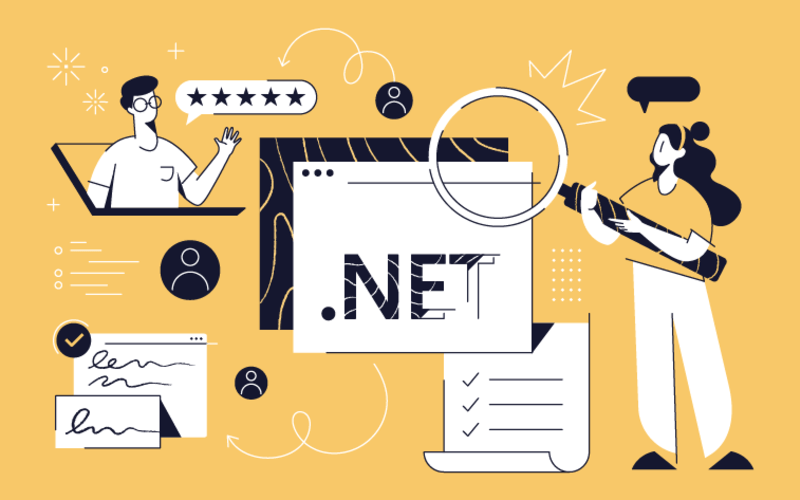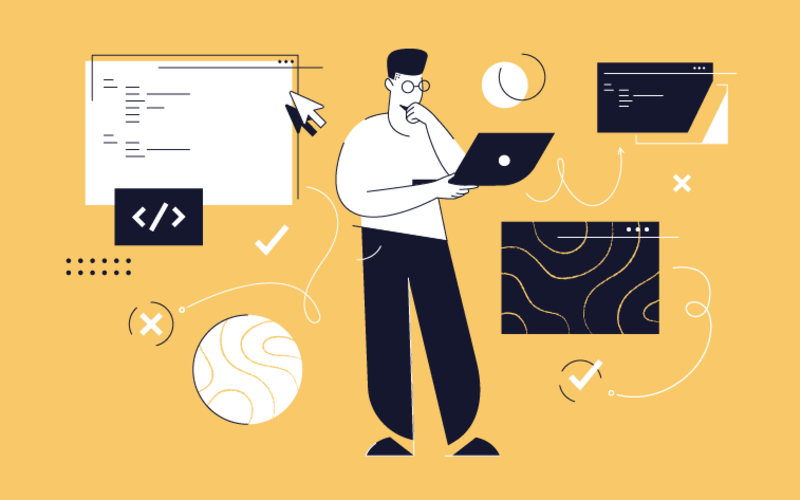We gathered the most valuable and essential questions you should ask in the initial interview stages from a React Native Senior developer and included the hard and soft skills you should pay attention to the most.
The importance of having a React Native developer in the company
A React Native developer is a professional who uses a JavaScript framework to create and build well structured, incredibly functional, native apps for a captivating user experience.
In today’s climate where countless apps are used for almost everything, investing in a skilled developer for your business’ apps is crucial. Everything is digital and accessible through an app, so you want to ensure the overal quality is as close to perfect as possible.
Gorgeous, dynamic apps with outstanding performance, all developed super-fast and cost-efficiently – this is an excellent reason to hire a React Native developer and to get the maximum of a candidate’s skills.
We can even level this up with a Senior React Native seasoned developer. Not only do senior, seasoned developers know the job’s ins and outs perfectly, but they can also be great at assessing the prospective developers you could hire for your teams. The hiring process of a developer can be streamlined in many ways, and relying on a senior developer’s perspective can be one of them.
We had an insightful talk with Nikolay Tomitov, a senior fullstack developer with extensive experience in mobile development. He highlighted the most important interview questions he would ask as a React Native developer.
Let’s have a look.
The interview questions a React Native developer would ask
Nikolay has given us a good understanding of what it means to have specific questions to test the skills of a potential new developer in the team. From his point of view, the following questions are essential.
How AI is shaping the future of programming
Discover the responses of developers from our network about their use of AI in their development work, the benefits and challenges they face, and their predictions for the future of AI in software development.
Answer: React Native uses native components to render content and performs JavaScript code on a separate thread. The community is very stable and viral as well, not to mention also Facebook supports it. It also allows Android and iOS development with a solid, satisfactory performance.
Q2: Explain ‘Flexbox’ styling and its usage in React Native.
Answer: Flexbox styling is a layout technology that enables elements to align correctly and distributes a space within a container. When we use Flexbox, everything in the container, or the whole content of it, can be nicely aligned to fill a space, or it can distribute space well between elements. This is an excellent way of working with responsive design systems. When we use this in React Native, it mimics the same Flexbox that we use in CSS, but by default, here, the default ‘flex direction’ is a column.
Q3: Why should someone choose React Native over native development?
Answer: React Native contains a massive community of developers, which is always incredibly helpful for anyone in development who wants to progress their work. It also allows cross-platform development for iOS, Android, and the web, making the work more practical and simpler. It supports hot reloading and makes the development work easy instead of dreaded. Underneath React Native, React is used, so for every update and fix directly to the React platform, the same is brought to React Native, and everything is well synchronized.
Q4: What are “hooks” in React Native?
Answer: The hooks represent a new addition in React. With hooks, we can use state and manage effects, contexts, or other React features without writing a class. Hooks are a popular, preferred way to develop components, and they pair with functions, not classes. Another good practice to consider is developing custom hooks for better business logic extraction.
Q5: How would you handle ‘state’ in a component?
Answer:
State is used to control the internal data of components. It is used by the useState hook: const [value, setValue] = useState(0)
This returns both the value and the setter function in an array. But the critical point here is that the setValue function works asynchronously, and this means if we call it, there won’t be immediate changes to the state. And also another thing here is that we can pass a function to it too, that accepts an old value.
Q6: What is the importance of ‘useEffect’ and its usage?
Answer: The useEffect hook allows us to perform side effects in the components when needed. There are some useful examples of side effects, such as:
⇨ Fetching data
⇨ Direct update of the DOM
⇨ Timers
It’s important to mention that useEffect always accepts two arguments:
⇨ The first argument is called effect, and this is a function
⇨ The second argument is optional and represents an array of dependencies
If some dependencies change within the dependency array, the code will be executed all over again. If we do not provide the array, useEffect will be executed once at the initial render of a component.
If we somehow miss this array, it will be called on each separate re-render (and this is not so ideal). So, we can also return a function from it, i.e., a tear-down function executed only after the unmounting of the component.
Q7: Elaborate on the leading and most essential components of the Redux library.
Answer: Redux represents a predictable state container for JavaScript apps. It does a great job of helping developers write apps that store and manage specific app data. The whole data flow from that app is handled within just one single point of truth.
Let’s focus on the three most essential components: the Actions, Reducers, and Store.
-
Actions – These contain a payload of data to the store. These represent the sole source of information for the store. In other words, if any change to the state is necessary, the required change will be dispatched through the actions.
-
Reducers – After the action is dispatched successfully, the reducers update the state accordingly and accurately by providing the current state, action type, and action payload. Then, a new state is returned from the reducer, or the old state is returned if this action does not apply to this reducer.
-
Store – This component contains the global state and the setup for reducers, commonly using the combineReducers approach.
Q8: Describe the debugger menu in React Native and how you would personally use it.
Answer: The React Native debugger menu is beneficial for easy project debugging or even debugging a current condition in real time. The following five can be used as described:
Reload for reloading the app
Enable Live Reload to enable the app to successfully reload on saving.
Debug JS Remotely to enable the usage of the JavaScript debugger.
Enable Hot Reloading to watch for any changes automatically.
Toggl Inspector for toggling the inspector interface which allows us to inspect UI elements (any UI element) we see on the screen and their properties.
Q9: Explain the Props Drilling and if there’s any way to avoid this.
Answer: The Props Drilling represents a prevalent error that always refers to a process where we pass data from a parent component to the exact precise child component that, in turn, goes through multiple other components that do not need this type of data for themselves.
We can somewhat avoid the Props Drilling by relying on the following three things: React Context API, Redux, and composition of components.
Q10: Explain the React Native Bridge.
Answer: Simply put, the React Native Bridge represents a layer – this layer is a connection that ties together React Native with the JavaScript environment. It is, in a way, a communication layer conjoining the native and the JavaScript code, which can also be used for developing custom integrations.
Q11: Elaborate on React Context.
Answer: The React Context represents an excellent way to manage a state globally. We can use this with the useState hook to share the state between those deeply-nested components much quicker than using useState on its own. Also, we can use the useContext hook as a better way to achieve all of this.
Q12: How would you handle the ‘exceptional cases’?
Answer: Exceptional cases are incredibly challenging to resolve, but fixing them is possible. They are mostly some failures from which it can be almost impossible to recover. Or they can also be apps that are hard to classify and don’t meet specific requirements.
There are a few great ways to handle these exceptional cases:
-
Common error component – To be shown in case anything that’s error-related occurs, which can refer to an error popup or some notification, for example.
-
Try/catch blocks – We use this in certain places to not leave out any unhandled promise rejections or unprocessed errors.
-
Proper checks – For the overall internet connectivity and support of offline mode too. This way, the user can not get stuck on some screen.
-
Error boundaries – To catch common errors and render proper components.
-
HTTP interceptors – To wrap known HTTP errors and handle them properly in the code that will be executed afterward.
Remember to tick off the hard and soft skills
Aside from using the questions mentioned above that a senior React Native developer would ask, you can also include other questions to assess all skills at once. But even more importantly, don’t forget to focus on the main aspects to conclude a successful interviewing process.
Confirm the must-have technical skills
Depending on your point of view and engagement needs, you can alter the interview questions and practical tests as you wish. But, try to follow a small checklist of must-have technical skills in a React Native developer. These skills are a must-know for anyone excellent at working with this framework.
-
At least four years of experience
-
Great experience with JavaScript and its code (how to build components, how to understand their flow, and also structuring the app logic and services too)
-
Expertise in iOS and Android development (familiarity with Swift, Objective-C)
-
Experience and knowledge in the basics of React (JSX, component lifecycle, Virtual DOM)
-
Thorough experience with Git
-
Maintained GitHub or GitLab profile
-
Excellent understanding of CSS, HTML, and functional programming
-
Solid experience and understanding of frontend
-
And, of course, overall aced technical and coding tests you gave them, with score results as high as possible
Confirm the soft skills
You can notice this aspect during the interviewing process and stages, so it’s not something specific to ask. Many small things a candidate does during an interview will give off telltale signs of what type of team member they will be, but there are several critical soft skills you must pay attention to.
Focus on whether a candidate:
-
Is on time for the virtual meetup
-
Has good English skills
-
Took care of their dress code, equipment, and the room where they had the call
-
Listens carefully and doesn’t interrupt when you’re talking
-
Shows curiosity for the job role and asks questions
-
Submits their answers to the questions / technical tests on time, within your given deadline
Their answers must show the following:
-
Attention to detail
-
Problem-solving thinking
-
Analytical skills
Conclusion
The benefits of having one or more React Native developers in the company are undeniable. These developers create gorgeous and functional APIs, beautiful UIs, and clean codes. Even more importantly, senior React Native developers can extend beyond their developer role and assist in interviewing candidates and assessing questions from their point of view.
And if you think about it, who would better formulate essential questions than a developer who already works with this skill? We hope the questions above will be helpful to you in recognizing good potential new members, and don’t forget to evaluate the hard and soft skills too.







